
Conférence
Jeudi 13 Mars 2008, 18h00
Auditoire SG, EPFL
Dans le cadre de l’exposition Julius Shulman, photographe
The camera constructs too
“Architecture and photography are more partners than rivals. The spread of the photographic image may have weakened the pedagogical intimidatory function of buildings, but at the end of the day a placid mutual accommodation has been reached. If Gurenberg’s revolution and the engraving raised by the possibility that these media would take over the communicative role of architecture, the fact is that the Vitor Hugo’s prophecy for Notre Dame – ceci tuera cela – has been belied by the facts; the mechanical reproduction of texts and images through engravings or photography has been able to substitute for the reprsentative function of buildings, which, on the contrary, have entered into resonance with the multiplication of their images to transform a potential rival into a virtual accomplice. Perret’s engraving did not compete with the granite pile of El Escorial; on the contrary, they brought about the worldwide dissemination of its lines and consolidated the fame of Juan de Herrera as author of the monastery, at the expense Juan Batista de Toledo. Likewise, Palladio’s prestige and influence was based more on his Quatro Libri, whose precepts are illustrated by his villas, than on the buildings themselves that doted the Venetian plain. And the stubborn fascination with the Seven Wonders of the ancient world is inconceivable without their popularisation in prints, which played the role of iconic minting that todaxy is entirely the task of photography.” (…)
Luis Fernàndez-Galiano
Luis Fernandez Galiano (1950) est architecte, professeur à l’Ecole d’Architecture de l’Université polytechnique de Madrid et éditeur du journal AV/Arquitectura Viva. Membre de la Royal Academy of Doctors, il a été Cullinan Professor à l’Université Rice, Franke Fellow à l’Université de Yale, invité au Getty Center de Los Angeles et à Princeton, Harvard et au Berlage Institut; il a enseigné au Menendez Pelayo et aux Universités Complutense. Président du Jury de la 9e Biennale d’Architecture de Venise et de la XVe Biennale d’Architecture au Chili, expert et membre du jury du Prix européen Mies van der Rohe, il a été le commissaire des expositions El espacio privado in Madrid and Extrreme Eurasia à Tokyo et a fait partie de plusieurs jurys de concours internationaux. Parmi ses ouvrages, citons La Quimera Moderna, Fire and Memory (MIT Press), Spain Builds (in collaboration with New York’s MoMA) and Atlas, Global Architecture circa 2000 (with the BBVA Foundation)